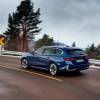
Toyota’s Petition Pushes NHTSA to Approve Advanced Headlights in the U.S.
Headlights play a significant role in ensuring road safety by illuminating the road ahead. However, traditional headlights are designed so that the resulting glare often blinds oncoming and preceding vehicles, increasing the risk of crashes. The resulting brightness can also impede the vision of pedestrians and bicyclists, which can result in further accidents. Toyota, a renowned global automaker, petitioned the NHTSA to introduce adaptive headlights in the U.S., hoping to ensure the safety of motorists and pedestrians.
Toyota’s petition to the NHTSA

According to Reuters, the U.S. National Highway Traffic Safety Administration (NHTSA) announced that cars on U.S. roads will now be permitted to use smart headlights, also known as adaptive driving beams, that help reduce nighttime crashes.
The NHTSA acted after Toyota Motor Corp filed a petition in 2013 to permit the headlights in the U.S. Smart headlights use additional sensors to automatically adjust the beams to illuminate without blinding the oncoming motorist.
Smart headlights have been authorized in Europe for decades and are applicable in Japan, Canada, and other countries. Alongside the Toyota Motor Corp., BMW AG and Volkswagen AG also filed a petition later to permit the use of smart headlights on U.S. cars.
How Toyota pushed for the approval of adaptive headlights in the U.S.
After a petition from Toyota to change the safety measures for lighting, the NHTSA proposed adjusting FMVSS 108 to develop performance standards and compliance assessment for adaptive-driving beam headlights.
Currently, the federal policies require distinct high and low-beam patterns. Thus, FMVSS 108 bans smart headlights on the basis that they dynamically adjust. Other than switching the high beams on and off, the ADB continuously adjusts the high-beam pattern to generate a shadow around other cars formed on input from a forward-looking camera.
According to Automotive Fleet, Toyota Motor Corp petitioned for the adoption of smart headlights as they provide high-beam visibility without the dangerous glare for oncoming road users. Additionally, advanced headlights have proven more useful in other countries like Japan.
If FMVSS 108 policy is adjusted, automakers who already provide smart headlights on cars sold in other countries would have to modify their technology for the U.S. market to match NHTSA assessment standards.
Why drivers need adaptive headlights
Adaptive headlights will enhance safety for pedestrians and bicyclists by increasing their visibility at night and will help reduce crashes by better illuminating animals and objects along the road. Smart headlights will provide drivers with better visibility and less distraction, thus allowing them to read the road and surrounding conditions and apply light only where necessary.
Currently, headlights on new vehicles are getting brighter. So, even low beam headlights can be distracting to other road users. Since ADB keeps bright lights off other road users, it is easier for pedestrians and other drivers to adhere to road policies. For instance, if there is an oncoming car, the beam is partially turned off so that the other driver is not blinded but still manages to focus bright light on the rest of the road.
Unlike traditional systems, ADB applies sensors, cameras, data-processing software, and headlamp hardware to detect all cars in front of you and automatically adjust the beams. The NHTSA has received complaints about headlight glare over the decades, particularly with the introduction of halogen lights in the late 1970s and then high-intensity discharge lights in the 1990s. Shifting to ADB will be huge in accomplishing its mission of prioritizing the safety of all road users.


